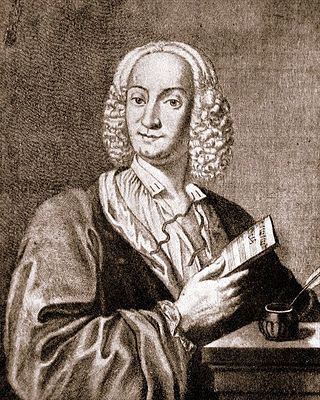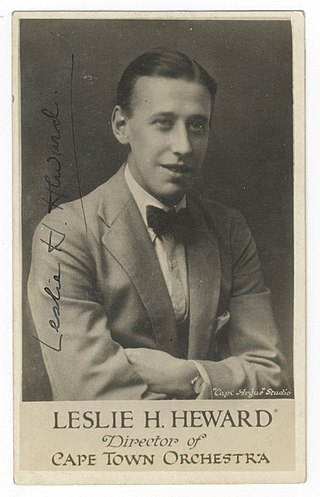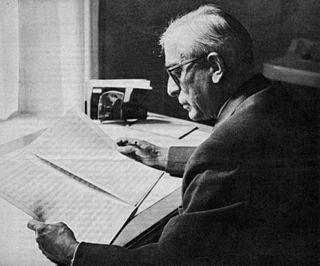
Ernest Alexandre Ansermet was a Swiss conductor.

The Rite of Spring is a ballet and orchestral concert work by the Russian composer Igor Stravinsky. It was written for the 1913 Paris season of Sergei Diaghilev's Ballets Russes company; the original choreography was by Vaslav Nijinsky with stage designs and costumes by Nicholas Roerich. When first performed at the Théâtre des Champs-Élysées on 29 May 1913, the avant-garde nature of the music and choreography caused a sensation. Many have called the first-night reaction a "riot" or "near-riot", though this wording did not come about until reviews of later performances in 1924, over a decade later. Although designed as a work for the stage, with specific passages accompanying characters and action, the music achieved equal if not greater recognition as a concert piece and is widely considered to be one of the most influential musical works of the 20th century.

The Four Seasons is a group of four violin concerti by Italian composer Antonio Vivaldi, each of which gives musical expression to a season of the year. These were composed around 1718–1720, when Vivaldi was the court chapel master in Mantua. They were published in 1725 in Amsterdam, together with eight additional concerti, as Il cimento dell'armonia e dell'inventione.

The Concerto for Orchestra, Sz. 116, BB 123, is a five-movement orchestral work composed by Béla Bartók in 1943. It is one of his best-known, most popular, and most accessible works.

Pulcinella is a 21-section ballet by Igor Stravinsky with arias for soprano, tenor and bass vocal soloists, and two sung trios. It is based on the 18th-century play Quatre Polichinelles semblables, or Four similar Pulcinellas, revolving around a stock character from commedia dell'arte. The work premiered at the Paris Opera on 15 May 1920 under the baton of Ernest Ansermet. The central dancer, Léonide Massine, created both the libretto and the choreography, while Pablo Picasso designed the costumes and sets. The ballet was commissioned by Sergei Diaghilev, impresario of the Ballets Russes. A complete performance takes 35–40 minutes. Stravinsky revised the score in 1965.
The Wedding, or Svadebka (Russian: Свадебка), is a Russian-language ballet-cantata by Igor Stravinsky scored unusually for four vocal soloists, chorus, percussion and four pianos. Dedicating the work to impresario Sergei Diaghilev, the composer described it in French as "choreographed Russian scenes with singing and music" [sic], and it remains known by its French name of Les noces despite being Russian.
The Variations on a Nursery Tune for piano and orchestra, Op. 25, were written by Ernst von Dohnányi in 1914. It is subtitled "For the enjoyment of friends of humor, to the annoyance of others" on the manuscript, though he omitted this inscription on the concert program and on the published edition, fearing that it might sound somewhat provocative. The work was premiered in Berlin on 17 February 1914.

Concerto in E-flat, inscribed Dumbarton Oaks, 8.v.38 (1937–38) is a chamber concerto by Igor Stravinsky, named for the Dumbarton Oaks estate of Robert Woods Bliss and Mildred Barnes Bliss in Washington, D.C., who commissioned it for their thirtieth wedding anniversary. Composed in Stravinsky's neoclassical period, the piece is one of Stravinsky's two chamber concertos and is scored for a chamber orchestra of flute, B♭ clarinet, bassoon, two horns, three violins, three violas, two cellos, and two double basses. The three movements, Tempo giusto, Allegretto, and Con moto, performed without a break, total roughly twelve minutes. The concerto was heavily inspired by Bach's set of Brandenburg Concertos, and was the last work Stravinsky completed in Europe, started in spring 1937 at the Château de Montoux near Annemasse, near Geneva, Switzerland, and finished in Paris on March 29, 1938.

Leslie Hays Heward was an English conductor and composer. Between 1930 and 1942 he was the Music Director of the City of Birmingham Orchestra.

Renard: histoire burlesque chantée et jouée, or The Fox: burlesque tale sung and played, is a chamber opera-ballet for four male voices and 16 instrumentalists written in 1916 by Igor Stravinsky. Its original Russian text, by the composer, derives from a folk tale as collected by Alexander Afanasyev — but the piece has no name in Russian, being titled generically instead as Байка про лису, петуха, кота да барана, or Tale of the Fox, the Cock, the Cat and the Ram. The premiere took place in a French translation in Paris on 18 May 1922. Duration: 16–17 minutes.
Le Baiser de la fée is a neoclassical ballet in one act and four scenes composed by Igor Stravinsky in 1928 and revised in 1950 for George Balanchine and the New York City Ballet. Based on Hans Christian Andersen's short story Isjomfruen, the work is an homage to Pyotr Ilyich Tchaikovsky, for the 35th anniversary of the composer's death. Stravinsky elaborated several melodies from early piano pieces and songs by Tchaikovsky in his score. A commission by Ida Rubinstein from 1927, the ballet was choreographed by Bronislava Nijinska and premiered in Paris on 27 November 1928.
The Piano Concerto No. 2 in G major, Sz. 95, BB 101 of Béla Bartók is a musical composition for piano and orchestra. The work, which was composed between 1930 and 1931, is notorious for being one of the most difficult pieces in the repertoire. Playing time is 26–29 minutes.
The Concerto for Piano and Wind Instruments was written by Igor Stravinsky in Paris in 1923–24. This work was revised in 1950.

Conrad Arthur Beck was a Swiss composer.
Chant du Rossignol, as it was published in 1921, is a poème symphonique by Igor Stravinsky adapted in 1917 from his 1914 opera The Nightingale.
This is a listing of all of Igor Stravinsky's commercially released studio recordings as a conductor or as a pianist; it also includes recordings conducted by Robert Craft "under the supervision of the composer." Works are arranged in chronological order by date of composition.

The Octet for wind instruments is a chamber music composition by Igor Stravinsky, completed in 1923.

José Antonio Cubiles Ramos was a noted Spanish pianist, conductor and teacher.
William Walton's Sinfonia Concertante is a three-movement piece for piano and orchestra, first performed in 1928. The composer revised it extensively in 1943. It is an early work, in the anti-romantic style favoured by Walton before the 1930s. There have been several recordings of the piece, featuring both the original and the revised versions.
![]() = 88 to 80, which contradicts the specification that the semiquavers remain the same. [8]
= 88 to 80, which contradicts the specification that the semiquavers remain the same. [8] 









